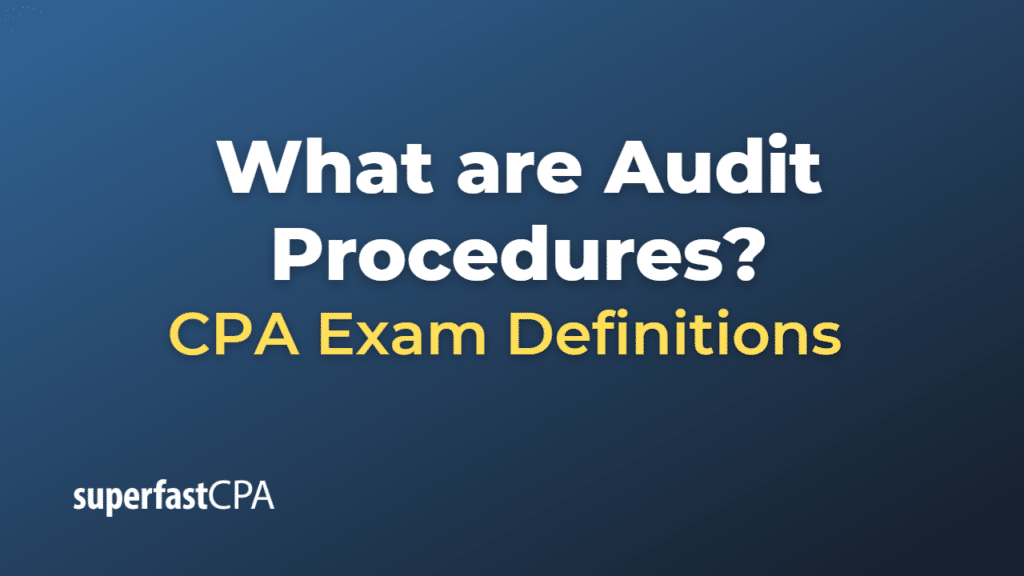Audit Procedures
Audit procedures are a set of systematic actions and techniques performed by auditors to gather sufficient, reliable, and relevant evidence to form an opinion on the fairness and accuracy of an entity’s financial statements. Audit procedures are designed to assess the effectiveness of an organization’s internal controls and detect any material misstatements or errors in the financial statements.
There are two main types of audit procedures:
- Test of controls: These procedures focus on evaluating the effectiveness of an organization’s internal control system. The purpose is to ensure that the controls are operating as intended and are preventing or detecting any errors or fraud. Test of controls may include:
- Inquiry: Asking management or employees about the internal controls.
- Observation: Watching the controls being performed by the employees.
- Inspection: Reviewing documents, such as policies and procedures, to verify that controls are documented and implemented.
- Reperformance: Repeating the control activities to verify their effectiveness.
- Substantive procedures: These procedures focus on testing the accuracy and completeness of the financial statement balances and transactions. The purpose is to detect material misstatements or errors that could affect the financial statements. Substantive procedures may include:
- Analytical procedures: Comparing financial statement balances and ratios with expectations based on historical trends, industry benchmarks, or other relevant factors.
- Tests of details: Examining transactions, account balances, and disclosures to verify their accuracy, completeness, and compliance with accounting standards.
- Vouching: Tracing transactions from the financial statements back to the supporting documentation, such as invoices, contracts, or receipts, to ensure their validity.
- Confirmation: Obtaining independent verification of account balances or transactions from third parties, such as banks, customers, or suppliers.
The selection and combination of audit procedures depend on the auditor’s assessment of the entity’s risks, the effectiveness of its internal controls, and the nature of the financial statement items being audited.
Example of Audit Procedures
Let’s consider an example of an audit procedure related to the revenue recognition process for a manufacturing company:
XYZ Manufacturing Company sells its products to customers and records revenue when the products are shipped. The company’s policy is to record sales only when the goods are shipped, and the risk of ownership has been transferred to the customer.
As an auditor, you are tasked with verifying the accuracy and completeness of the company’s recorded sales. You decide to perform a combination of test of controls and substantive procedures.
- Test of controls:
- Inquiry: You ask the company’s sales and shipping personnel about their understanding of the revenue recognition policy and how they ensure that sales are recorded only upon shipment.
- Observation: You observe the shipping process to ensure that employees are following the company’s policy and recording sales only when goods are shipped.
- Inspection: You review the company’s documented revenue recognition policy and verify that it is in line with the accounting standards.
- Reperformance: You select a sample of sales transactions and reperform the controls, such as checking that the shipping documents are in order before recognizing revenue.
- Substantive procedures:
- Analytical procedures: You compare the company’s sales trends with industry benchmarks and historical patterns, looking for any unusual fluctuations or discrepancies that may require further investigation.
- Tests of details: You select a sample of sales transactions and verify the accuracy and completeness of the recorded amounts by reviewing the underlying invoices, shipping documents, and customer purchase orders.
- Vouching: You trace a sample of recorded sales transactions back to the supporting documentation, such as shipping documents and customer purchase orders, to ensure their validity.
- Confirmation: You send sales confirmations to a sample of the company’s customers, requesting them to confirm the accuracy of the sales transactions recorded by XYZ Manufacturing Company.
By performing these audit procedures, you gather sufficient and appropriate audit evidence to form an opinion on the accuracy and completeness of the company’s revenue recognition process.













